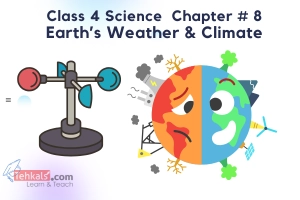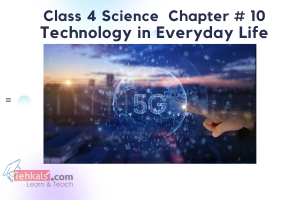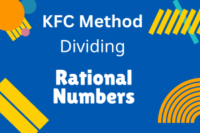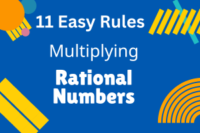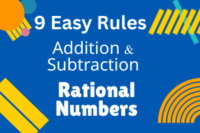Class 4 Science MCQs Chapter 9
Published: 2 Oct 2022
Welcome to tehkals.com, your go-to destination for Class 4 Science MCQs Chapter 9. Explore our comprehensive collection of Class 4 Science MCQs of Chapter No. 9, focusing on “Earth in the Solar System.”
If you want to succeed and clear your PST, CT, DM, PT, CT, TT, SST, and SS Tests, then our comprehensive MCQs (Multiple Choice Questions) provide the perfect solution by giving the treasure of knowledge and bank of MCQs.
Class 4 Science MCQs Chapter 9
Earth in the Solar System
Chapter No. 9 Test # 1
1. The ___________ is huge sphere of burning gases.(a) Cylinder
(b) Earth
(c) Moon
(d) Sun
Show Answer
Sun
2. The sun is a_________.
(a) Galaxy
(b) Moon
(c) Star
(d) ball
Show Answer
Star
3. The sun emits:
(a) Light
(b) Heat
(c) Both a & b
(d) None of these
Show Answer
Both a & b
4. The Earth and the Moon, other planets, comets and asteroids etc. revolve around the sun due to the ___________ofthesun.
(a) Center
(b) Gravity
(c) Magnetic field
(d) Solar system
Show Answer
Gravity
5. The sun is the __________ of solar system.
(a) Power station
(b) Part
(c) Center
(d) Planet
Show Answer
Center
6. The closest star to Earth is the _________.
(a) Mercury
(b) Sun
(c) Moon
(d) None of these
Show Answer
Sun
7. Solar system consists of all the planets which ______ around the sun.
(a) Runs away
(b) Close
(c) Revolves
(d) None of these
Show Answer
Revolves
8. The first planet that revolves closest to the sun is______.
(a) Jupiter
(b) Venus
(c) Earth
(d) Mercury
Show Answer
Mercury
9. The circular path of a planet around the sun is called a/an______.
(a) Solar system
(b) Planets
(c) Both a & b
(d) Orbit
Show Answer
Orbit
10. The time taken by a planet to complete one orbit is called a/an ___period.
(a) Time
(b) Solar
(c) Orbital
(d) All of these
Show Answer
Orbital
11. ________ is the largest planet in the solar system.
(a) Venus
(b) Jupiter
(c) Neptune
(d) Uranus
Show Answer
Jupiter
12. ______ is the brightest object appearing in the sky after the sun is the Moon.
(a) Venus
(b) Jupiter
(c) Neptune
(d) Uranus
Show Answer
Venus
13. The third biggest thing appearing in the sky after the sun and moon is _____.
(a) Venus
(b) Jupiter
(c) Neptune
(d) Uranus
Show Answer
Venus
14. The natural satellites of the Earth are _______.
(a) Sun
(b) Jupiter
(c) Moon
(d) All of these
Show Answer
Moon
15. Moon complete one revolution around the Earth is about _______days.
(a) 28.5
(b) 29.5
(c) 30.5
(d) None of these
Show Answer
29.5
16. The moon completes one round around earth in ______
(a) 27.3
(b) 28.3
(c) 29.3
(d) 30.3
Show Answer
27.3
17. The moon completes one round around earth in 27.3 days and since earth is also moving, so moon is completed for us in ______
(a) 28.5
(b) 29.5
(c) 30.5
(d) None of these
Show Answer
29.5
18. Among all the celestial bodies, ________ is the closest to the Earth.
(a) Jupitar
(b) Mercury
(c) Sun
(d) Moon
Show Answer
Moon
19. The distance between Earth and Moon is about _______km.
(a) 284,000
(b) 384,000
(c) 484,000
(d) 584,000
Show Answer
384,000
20. The diameter of the moon is about _______km.
(a) 2,500
(b) 3,000
(c) 3,500
(d) None of thee
Show Answer
3,500
21. The ebb and flow of the ________in the sky is due to its rotation around Earth.
(a) Sun
(b) Jupiter
(c) Venus
(d) Moon
Show Answer
Moon
22. On the first day of lunar month, the very narrow shape of Moon is known as______.
(a) Full moon
(b) Badar
(c) Crescent
(d) Both a & b
Show Answer
Crescent
23. Complete moon is called ______
(a) Full moon
(b) Badar
(c) Crescent
(d) Both a & b
Show Answer
Both a & b
24. Life _______on the Moon.
(a) Exists
(b) Does not exit
(c) Already continue
(d) Disappears
Show Answer
Does not exit
25. Water _____ on the Moon.
(a) Exists
(b) Does not exist
(c) Already continue
(d) Disappears
Show Answer
Does not exist
26. The Moon has ______ atmosphere.
(a) Many
(b) One
(c) Two
(d) no
Show Answer
no
27. All planets of solar system have moons except:
(a) Mercury
(b) Venus
(c) Both a & b
(d) Jupiter
Show Answer
Both a & b
28. Which planets have maximum number of Moons?
(a) Jupiter
(b) Saturn
(c) Both a & b
(d) None of these
Show Answer
Both a & b
Chapter No. 9 Test # 2
29. What is/are the movement of earth(a) Revolves around the sun
(b) Rotates about its own axis
(c) Both a & b
(d) None of these
Show Answer
Both a & b
30. The axis is a/an _________ line that passes through the north and south poles of the Earth.
(a) Real
(b) Imaginary
(c) Zig zag
(d) None of these
Show Answer
Imaginary
31. When earth is in front of the sun, it means that it is ______.
(a) Day
(b) Night
(c) Noon
(d) No shadow
Show Answer
Day
32. The earth completes one rotation around its axis in ________
(a) 24 hours
(b) 30 days
(c) 365 days
(d) None of these
Show Answer
24 hours
33. Day and night are due to ________ motion of the earth.
(a) Revolution
(b) Rotational
(c) Translatory
(d) None of these
Show Answer
Rotational
34. The earth rotates from ___________
(a) South to east
(b) North to east
(c) East to west
(d) West to east
Show Answer
West to east
35. The sun rises in the east because earth rotates from
(a) South to east
(b) North to east
(c) East to west
(d) West to east
Show Answer
West to east
36. The duration of day on different planets is ______
(a) Same
(b) Equal
(c) Different
(d) 24 hrs
Show Answer
Different
37. The Earth complete one revolution around the sun in about _______days.
(a) 27.3
(b) 29.5
(c) 365
(d) One38. The period of 365 days is called ______ year.
(a) 12
(b) One
(c) 365
(d) All of these
Show Answer
One
39. When sun rays fall vertically at the northern hemisphere, then the duration of day _______
(a) Increases
(b) Decreases
(c) Both at the same time
(d) None of these
Show Answer
Increases
40. When the southern hemisphere of the earth receives slanting sun rays, the duration of day _____
(a) Increases
(b) Decreases
(c) Both at the same time
(d) None of these
Show Answer
Decreases
41. At which day/days the day and night are equal.
(a) 22 December
(b) 21 March
(c) 23 September
(d) Both b & c
Show Answer
Both b & c
42. At which date has the longest day.
(a) 22 June
(b) 21 March
(c) 23 September
(d) Both b & c
Show Answer
22 June
43. At which date has the shortest day.
(a) 22 December
(b) 21 March
(c) 23 September
(d) Both b & c
Show Answer
22 December
44. At which date has the longest night.
(a) 22 December
(b) 21 March
(c) 23 September
(d) Both b & c
Show Answer
22 December
45. At which date has the shortest night.
(a) 22 December
(b) 22 June
(c) 23 September
(d) Both b & c
Show Answer
22 June
46. The annual rotation of the Earth and the tilt in its axis cause changes in_____.
(a) Motion
(b) Season
(c) Rotation
(d) Revolution
Show Answer
Season
47. When the Earth comes between the sun and the Moon, a shadow of the Earth is formed on the Moon and it looks dark, this called ________eclipse.
(a) Solar
(b) lunar
(c) Normal
(d) High
Show Answer
lunar
48. When the moon comes between the Earth and the sun. Sun is hidden behind the Moon and a shadow of the moon falls on the Earth, it is called ________eclipse.
(a) Solar
(b) Lunar
(c) Normal
(d) High
Show Answer
Solar
49. The gravity of which body keeps the planets and other celestial bodies together in the solar system?
(a) Jupiter
(b) Earth
(c) Sun
(d) Moon
Show Answer
Sun
50. The Earth completes its rotation around the sun in 365 days. This period is called:
(a) Solar year
(b) Solar month
(c) Lunar month
(d) Lunar year
Solar year
Show Answer
51. Due to the annual revolution of Earth and tilt of its axis:
(a) Day and night are formed
(b) Seasons change
(c) Eclipses are formed
(d) Shadow are formed
Show Answer
Seasons change
52. One the globe, in which part of the Earth is Pakistan situated?
(a) Northern hemisphere
(b) Southern hemisphere
(c) Equator
(d) Half in northern and half in southern hemisphere
Show Answer
Northern hemisphere
53. Which planet of solar system does not have any moon?
(a) Jupiter
(b) Venus
(c) Mars
(d) Saturn
Show Answer
Venus

- Be Respectful
- Stay Relevant
- Stay Positive
- True Feedback
- Encourage Discussion
- Avoid Spamming
- No Fake News
- Don't Copy-Paste
- No Personal Attacks



- Be Respectful
- Stay Relevant
- Stay Positive
- True Feedback
- Encourage Discussion
- Avoid Spamming
- No Fake News
- Don't Copy-Paste
- No Personal Attacks
